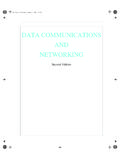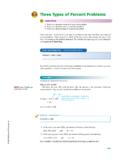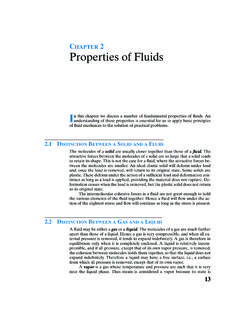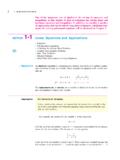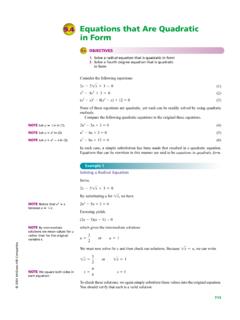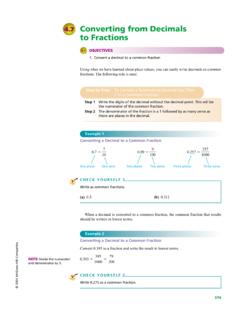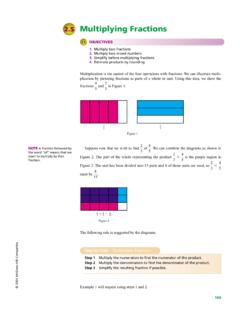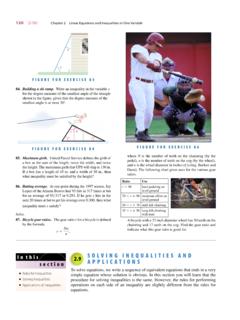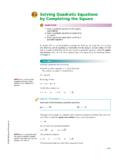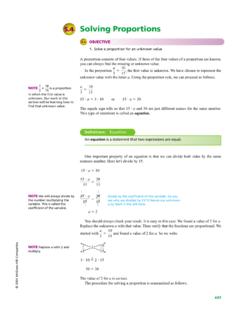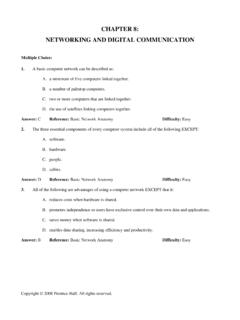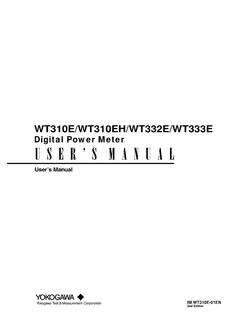Transcription of DATA COMMUNICATIONS AND NETWORKING
1 FM Page i Wednesday, February 23, 2000 2:30 PM. DATA COMMUNICATIONS . AND. NETWORKING . Second Edition FM Page ii Wednesday, February 23, 2000 2:30 PM. FM Page iii Wednesday, February 23, 2000 2:30 PM. DATA COMMUNICATIONS . AND. NETWORKING . Second Edition Behrouz A. Forouzan DeAnza College with Catherine Coombs and Sophia Chung Fegan Boston Burr Ridge, IL Dubuque, IA Madison, ork WISan New Francisco Y St Bangkok Bogot Caracas Lisbon London Madrid Mexico City Milan New Delhi Seoul e Sydney Singapor aipei T oronto T. FM Page iv Wednesday, February 23, 2000 2:30 PM. DATA COMMUNICATIONS AND NETWORKING . Published by McGraw-Hill, an imprint of the McGraw-Hill Companies, Inc. 1221 Avenue of the Americas, New York, NY, 10020. Copyright 2001, 1998 by The McGraw-Hill Companies, Inc. All rights reserved. No part of this publication may be reproduced or distributed in any form or by any means, or stored in a database or retrieval system, without the prior written consent of The McGraw-Hill Companies, Inc.
2 , including, but not limited to, in any network or other electronic storage or transmission, or broadcast for distance learning. This book is printed on acid-free paper. 1 2 3 4 5 6 7 8 9 0 DOC/DOC 0 9 8 7 6 5 4 3 2 1 0. ISBN 0-07-232204-7. Publisher: Thomas Casson Executive editor: Elizabeth A. Jones Developmental editor: Emily J. Gray Senior marketing manager: John T. Wannemacher Senior project manager: Amy Hill Senior production supervisor: Heather D. Burbridge Freelance design coordinator: Gino Cieslik Supplement coordinator: Susan Lombardi New media: Christopher Styles Cover design: Joanne Schopler Cover illustration: Tony Stone Compositor: Interactive Composition Corporation Typeface: 10/12 Times Roman Printer: R. R. Donnelley & Sons Company [CIP to come]. FM Page v Wednesday, February 23, 2000 2:30 PM. To Faezeh with love. FM Page vi Wednesday, February 23, 2000 2:30 PM. FM Page vii Wednesday, February 23, 2000 2:30 PM. BRIEF CONTENTS. Contents ix Preface xxvii Chapter 1 Introduction 1.
3 Chapter 2 Basic Concepts 21. Chapter 3 The OSI Model 43. Chapter 4 Signals 65. Chapter 5 Encoding and Modulating 91. Chapter 6 Transmission of digital Data: Interfaces and Modems 139. Chapter 7 Transmission Media 187. Chapter 8 Multiplexing 231. Chapter 9 Error Detection and Correction 273. Chapter 10 Data Link Control 301. Chapter 11 Data Link Protocols 329. Chapter 12 Local Area Networks 369. Chapter 13 Metropolitan Area Networks 413. Chapter 14 Switching 431. vii FM Page viii Wednesday, February 23, 2000 2:30 PM. viii BRIEF CONTENTS. Chapter 15 Point-to-Point Protocol (PPP) 455. Chapter 16 Integrated Services digital Network (ISDN) 471. Chapter 17 505. Chapter 18 Frame Relay 525. Chapter 19 ATM 553. Chapter 20 SONET/SDH 593. Chapter 21 NETWORKING and Internetworking Devices 613. Chapter 22 Transport Layer 657. Chapter 23 Upper OSI Layers 677. Chapter 24 TCP/IP Protocol Suite: Part 1 705. Chapter 25 TCP/IP Protocol Suite: Part 2, Application Layer 737. Appendix A ASCII Code 777.
4 Appendix B Numbering Systems and Transformation 783. Appendix C Representation of Binary Numbers 791. Appendix D Fourier Analysis 799. Appendix E Hardware Equipment for Error Detection 803. Appendix F Huffman Coding 811. Appendix G LZW (Lempel-Ziv-Welch) Compression Method 817. Appendix H Next Generation of TCP/IP Protocol Suite: IPv6. and ICMPv6 825. Appendix I Spanning Tree 839. Glossary 845. Acronyms 877. Index 000. FM Page ix Wednesday, February 23, 2000 2:30 PM. TABLE OF. CONTENTS. Preface xxvii Chapter 1 Introduction 1. WHY STUDY DATA COMMUNICATIONS 1. DATA COMMUNICATION 2. Components 3. NETWORKS 4. Distributed Processing 4. Network Criteria 5. Applications 6. PROTOCOLS AND STANDARDS 7. Protocols 7. Standards 8. STANDARDS ORGANIZATIONS 9. Standards Creation Committees 9. Forums 12. Regulatory Agencies 13. STRUCTURE OF THE BOOK 13. KEY TERMS AND CONCEPTS 13. SUMMARY 14. PRACTICE SET 15. Review Questions 15. Multiple Choice 16. Exercises 18. Chapter 2 Basic Concepts 21.
5 LINE CONFIGURATION 21. Point-to-Point 21. Multipoint 22. TOPOLOGY 22. Mesh 23. Star 25. Tree 25. ix FM Page x Wednesday, February 23, 2000 2:30 PM. x TABLE OF CONTENTS. Bus 26. Ring 27. Hybrid Topologies 28. TRANSMISSION MODE 28. Simplex 29. Half-Duplex 29. Full-Duplex 29. CATEGORIES OF NETWORKS 30. Local Area Network (LAN) 30. Metropolitan Area Network (MAN) 32. Wide Area Network (WAN) 32. INTERNETWORKS 33. KEY TERMS AND CONCEPTS 33. SUMMARY 34. PRACTICE SET 35. Review Questions 35. Multiple Choice 36. Exercises 38. Chapter 3 The OSI Model 43. THE MODEL 43. Layered Architecture 43. FUNCTIONS OF THE LAYERS 47. Physical Layer 47. Data Link Layer 48. Network Layer 49. Transport Layer 51. Session Layer 53. Presentation Layer 54. Application Layer 55. Summary of Layer Functions 56. TCP/IP PROTOCOL SUITE 56. KEY TERMS AND CONCEPTS 57. SUMMARY 58. PRACTICE SET 59. Review Questions 59. Multiple Choice 60. Exercises 63. Chapter 4 Signals 65. ANALOG AND digital 65. Analog and digital Data 66.
6 Analog and digital Signals 66. APERIODIC AND PERIODIC SIGNALS 66. Periodic Signals 67. Aperiodic Signals 67. ANALOG SIGNALS 68. Simple Analog Signals 68. FM Page xi Wednesday, February 23, 2000 2:30 PM. TABLE OF CONTENTS xi TIME AND FREQUENCY DOMAIN 74. COMPOSITE SIGNALS 75. Frequency Spectrum and Bandwidth 76. digital SIGNALS 79. Decomposition of a digital Signal 80. KEY TERMS AND CONCEPTS 81. SUMMARY 82. PRACTICE SET 83. Review Questions 83. Multiple Choice 84. Exercises 86. Chapter 5 Encoding and Modulating 91. digital -TO- digital CONVERSION 92. Unipolar 92. Polar 94. Bipolar 97. ANALOG-TO- digital CONVERSION 102. Pulse Amplitude Modulation (PAM) 102. Pulse Code Modulation (PCM) 103. Sampling Rate 104. How Many Bits Per Sample 106. Bit Rate 107. digital -TO-ANALOG CONVERSION 107. Aspects of digital -to-Analog Conversion 108. Amplitude Shift Keying (ASK) 109. Frequency Shift Keying (FSK) 111. Phase Shift Keying (PSK) 113. Quadrature Amplitude Modulation (QAM) 116. Bit/Baud Comparison 118.
7 ANALOG-TO-ANALOG CONVERSION 120. Amplitude Modulation (AM) 121. Frequency Modulation (FM) 122. Phase Modulation (PM) 125. KEY TERMS AND CONCEPTS 125. SUMMARY 126. PRACTICE SET 127. Review Questions 127. Multiple Choice 128. Exercises 133. Chapter 6 Transmission of digital Data: Interfaces and Modems 139. digital DATA TRANSMISSION 139. Parallel Transmission 140. Serial Transmission 141. DTE-DCE INTERFACE 143. Data Terminal Equipment (DTE) 144. FM Page xii Wednesday, February 23, 2000 2:30 PM. xii TABLE OF CONTENTS. Data Circuit Terminating Equipment (DCE) 144. Standards 145. EIA-232 Interface 145. OTHER INTERFACE STANDARDS 152. EIA-449 153. EIA-530 157. 158. MODEMS 159. Transmission Rate 160. Modem Standards 164. 56K MODEMS 171. Traditional Modems 171. 56K Modems 172. Why Only 56 Kbps? 174. CABLE MODEM 174. Downloading 174. Uploading 175. KEY TERMS AND CONCEPTS 175. SUMMARY 176. PRACTICE SET 177. Review Questions 177. Multiple Choice 179. Exercises 185. Chapter 7 Transmission Media 187.
8 GUIDED MEDIA 188. Twisted-Pair Cable 188. Coaxial Cable 192. Optical Fiber 193. UNGUIDED MEDIA 200. Radio Frequency Allocation 200. Propagation of Radio Waves 200. Terrestrial Microwave 205. Satellite Communication 206. Cellular Telephony 208. TRANSMISSION IMPAIRMENT 211. Attenuation 211. Distortion 213. Noise 213. PERFORMANCE 214. Throughput 214. Propagation Speed 215. Propagation Time 215. WAVELENGTH 215. SHANNON CAPACITY 216. MEDIA COMPARISON 217. KEY TERMS AND CONCEPTS 218. SUMMARY 220. FM Page xiii Wednesday, February 23, 2000 2:30 PM. TABLE OF CONTENTS xiii PRACTICE SET 222. Review Questions 222. Multiple Choice 223. Exercises 230. Chapter 8 Multiplexing 231. MANY TO ONE/ONE TO MANY 231. FREQUENCY-DIVISION MULTIPLEXING (FDM) 232. WAVE-DIVISION MULTIPLEXING (WDM) 235. TIME-DIVISION MULTIPLEXING (TDM) 236. Inverse Multiplexing 244. MULTIPLEXING APPLICATION: THE TELEPHONE SYSTEM 245. Common Carrier Services and Hierarchies 245. Analog Services 246. digital Services 248.
9 digital SUBSCRIBER LINE (DSL) 254. ADSL 254. RADSL 255. HDSL 256. SDSL 256. VDSL 256. FTTC 257. FTTC in the Telephone Network 257. FTTC in the Cable TV Network 257. KEY TERMS AND CONCEPTS 258. SUMMARY 259. PRACTICE SET 261. Review Questions 261. Multiple Choice 262. Exercises 266. Chapter 9 Error Detection and Correction 273. TYPES OF ERRORS 273. Single-Bit Error 273. Burst Error 274. DETECTION 275. Redundancy 275. VERTICAL REDUNDANCY CHECK (VRC) 277. LONGITUDINAL REDUNDANCY CHECK (LRC) 279. CYCLIC REDUNDANCY CHECK (CRC) 280. Performance 284. CHECKSUM 284. ERROR CORRECTION 287. Single-Bit Error Correction 287. Hamming Code 289. Burst Error Correction 291. FM Page xiv Wednesday, February 23, 2000 2:30 PM. xiv TABLE OF CONTENTS. KEY TERMS AND CONCEPTS 292. SUMMARY 293. PRACTICE SET 294. Review Questions 294. Multiple Choice 294. Exercises 298. Chapter 10 Data Link Control 301. LINE DISCIPLINE 302. ENQ/ACK 302. Poll/Select 304. FLOW CONTROL 306. Stop-and-Wait 308. Sliding Window 308.
10 ERROR CONTROL 312. Automatic Repeat Request (ARQ) 312. Stop-and-Wait ARQ 312. Sliding Window ARQ 315. KEY TERMS AND CONCEPTS 321. SUMMARY 321. PRACTICE SET 322. Review Questions 322. Multiple Choice 323. Exercises 326. Chapter 11 Data Link Protocols 329. ASYNCHRONOUS PROTOCOLS 330. XMODEM 330. YMODEM 331. ZMODEM 331. BLAST 331. Kermit 331. SYNCHRONOUS PROTOCOLS 332. CHARACTER-ORIENTED PROTOCOLS 332. Binary Synchronous Communication (BSC) 333. BSC Frames 334. Data Transparency 337. BIT-ORIENTED PROTOCOLS 339. HDLC 340. Frames 342. More about Frames 348. Examples 353. LINK ACCESS PROCEDURES 357. LAPB 357. LAPD 358. LAPM 358. KEY TERMS AND CONCEPTS 358. FM Page xv Wednesday, February 23, 2000 2:30 PM. TABLE OF CONTENTS xv SUMMARY 359. PRACTICE SET 360. Review Questions 360. Multiple Choice 361. Exercises 364. Chapter 12 Local Area Networks 369. PROJECT 802 369. IEEE 370. LLC 371. MAC 371. Protocol Data Unit (PDU) 371. ETHERNET 372. Access Method: CSMA/CD 373. Addressing 374.
